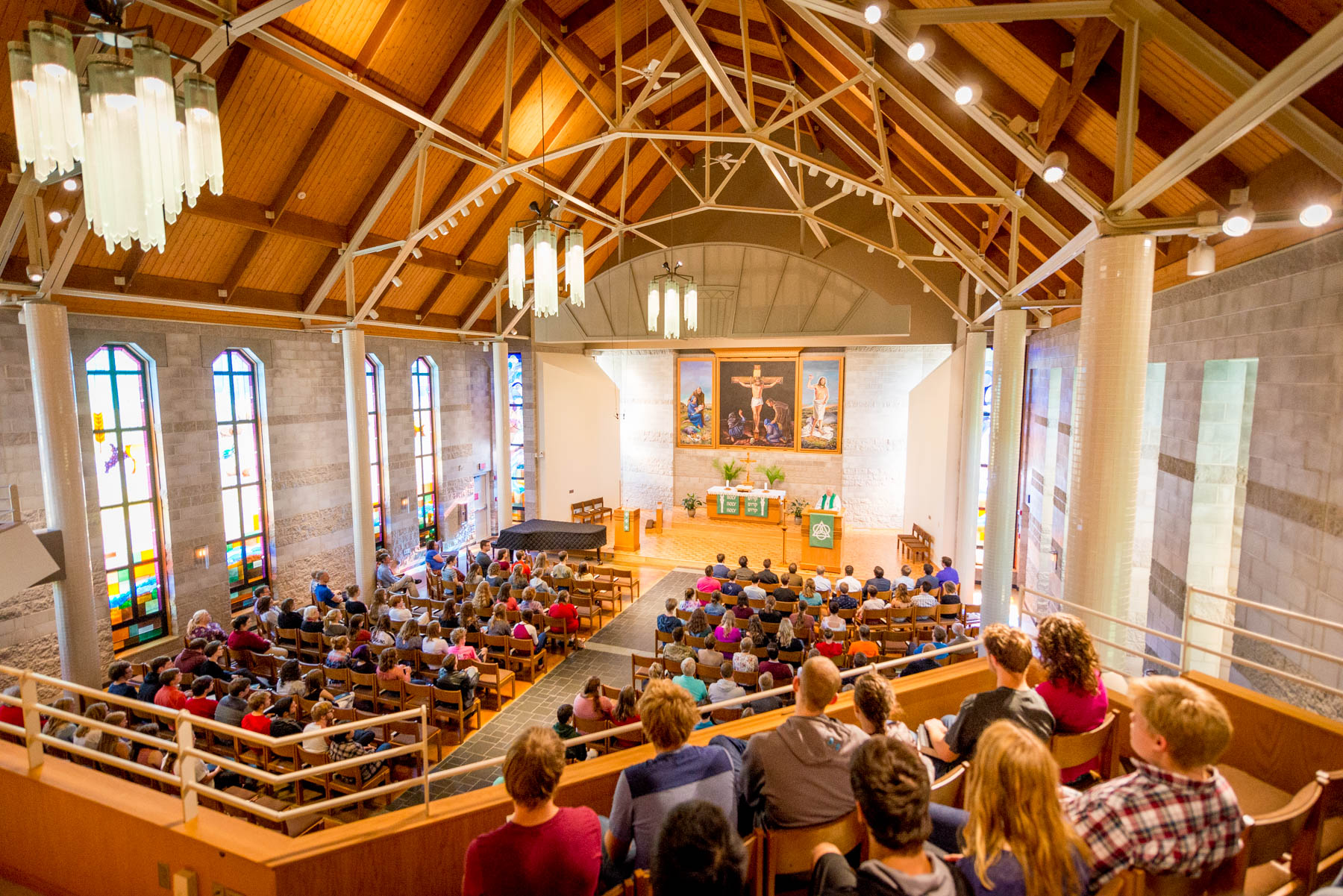Help, My Church is Bare!
As the Wisconsin Evangelical Lutheran Synod continues its 100 Missions in 10 Years initiative, that’s a lot of churches that will need to ask themselves the tough questions about what they value and what they can afford as far as artwork. After all, as long as the gospel is being preached that’s the one thing needful, right? Designer Mara Rugen and artist Jonathan Mayer would say that’s all the more reason to portray the gospel visually to hit the point home.
Whether they are meeting in a school gym or an aged steepled building, churches can benefit from considering how they are using their space to communicate the gospel message. I asked a mission-focused designer and a traditional Lutheran painter on what they believe is important in liturgical artwork to give a starting point for churches:

Mara Rugen
Into the World Designs
Mara Rugen created Into the World Designs while still a student at Wisconsin Lutheran College, where she designed and sold Christian products. After graduating she is taking her mission mindset literally by helping to found a mission congregation in Idaho.
Jonathan Mayer
Scapegoat Studio
Jonathan Mayer is a liturgical artist whom you may recognize from his 2010 Behold the Lamb of God painting, in which a sacrificial lamb spills blood in the shape of the continents. Most recently he has been using his liturgical art skills to design stained glass for the prestigious Willet Hauser Architectural Glass company. He has compiled a summary of how to commission liturgical art at LutheranArt.com.

Mara Rugen:
I think some powerful artwork that a church could utilize would be pieces that depict the great love that God has for us. This could be through significant figures in the Bible where God’s faithfulness is evident in their lives but definitely art of the gospel and how Jesus came to this earth for us. Having art that makes someone learn more about God’s love and see it displayed in a unique way can be powerful and impactful on one’s faith and understanding of our Father in heaven. Even art that brings scripture to life: Bible passages that are meaningful can be even more powerful when displayed through art.

My idea of a church that uses its full potential of visuals to support the message would be art that uses color but also pulls at the emotions of those viewing it. Some examples could be joy, gratefulness, sadness, etc.; it’s up to the church and the artist to decide what emotions are most applicable for each church location and the type of art they want displayed. One location I have always referred to when I think of a church that has beautiful art displayed is Bethany Lutheran College. One of the professors at Bethany, William Bukowski, hand-painted a mural for their college’s chapel, and when I visited it stood out to me. It made me picture Christ’s love and visualize how great he is. Another artist whose work I love is Chris Powers. His art helps you see at the same Bible stories from a different perspective. Lori Ehlke is another artist I know; her husband is a Pastor in Onalaska. She taught me art in high school (she’s so talented) and has done murals and verse art.
I notice that more contemporary churches are using more abstract art for their church; this can hold meaning and allow the viewer some creative freedom in taking away meaning that is unique for them. Personally, however, I think that more traditional artwork displaying settings from Christ’s life are very powerful. I always love seeing and hearing how each person sees God’s love in their lives. Having art that depicts those unique perspectives allows the congregation to view Christ and God from a different angle.
Utilize the talents and skills that God has blessed your congregation with. Church art doesn’t have to be front or center, it can be displayed in flyers, church bulletins, emails, etc. Use the great things God has given you!
Jonathan Mayer:
Liturgical art is important for many reasons. You could almost do a whole post to expound each of the following reasons!
[See Scapegoat Studio About page for Jonathan’s essays on the subject.]
A. Art in the church is important because beauty is important.
God is beauty. His creation is beautiful. And we, his creations, are made to recognize and appreciate beauty. Worshipping in a space that is made to be beautiful is natural for believers (in both the Old and New Testaments). Conversely, worshipping in an ugly church would be incongruous.
B. The visual arts are important in the church because they always communicate, whether we intend them to or not.
A work of art communicates something—but so does a lack of artwork. So we want to be intentional about what we communicate, and how we communicate it. Our beliefs are manifested in the houses of worship we create, even the materials we use. What are we saying about our God?
C. Since art communicates, it is useful for teaching.
Yes, Lutherans are quick to latch onto visual art if we can squeeze some utility out of it—and that is certainly not a bad thing. If Lutherans thought the only purpose of art was to catechize, we could still go very far with it. In the hands of skilled artists, the truths of scripture transcend the written word and preach passively to our eyes, even while the spoken word preaches to our ears. This taps into the sacramental aspects of worship—that if the gospel truths are faithfully portrayed through visual means, the art becomes a “handmaiden to theology” (to borrow Luther’s terminology), and God may work through it to strengthen our faith.
D. From a vocational standpoint, liturgical art is important because God has given us those talents to develop and use to his glory.
One body, many parts. Certainly, artistic gifts can be used to God’s glory outside of the church, but if the example of Bezalel (Exodus 35, 36) is anything to go by, then using them to beautify the church itself is also God-pleasing. If the didactic nature of art exposes a potential for sacramental benefits, then here is also a sacrificial aspect. A high standard of artistic beauty is not cheap, but reflects a reverence for the place where God physically meets us with his gifts of forgiveness, life, and salvation. The Christian heart, in faith, is moved to give God his or her absolute best.
E. Houses of worship should be set apart from daily life.
Holy means “set apart.” This does not mean that every church or chapel needs to look like a Gothic cathedral. But it does mean that ecclesiastical architecture is clearly distinguished from residential, commercial, and industrial architecture. It means that when we choose to beautify the inside of God’s house, we’ll do it in a way that is distinct from how we furnish and decorate our homes and offices. That “Sabbath” time of worship is meant to be an oasis—we step out of our mundane daily lives and put one foot in heaven. We turn off / tune out the noise of the world and sit at Jesus’ feet to listen to his voice. In the same way that smelling a whiff of a hot apple pie makes you yearn for a reunion with your grandmother (and a slice of the real thing!), a beautiful, well-crafted worship space should make us yearn for heaven.
[Share these points with your pastor or members when they ask why your church needs artwork!]
Lutheran Art Resource
LutheranArt.com is a resource that Jonathan Mayer and Jason Jaspersen put together explaining the process of commissioning Lutheran art.
This is an invaluable primer for churches, even listing artists you can contact for paintings, furnishings, paraments, and architecture.
Check out the Lutheran Art Resource today and make your church less bare!


